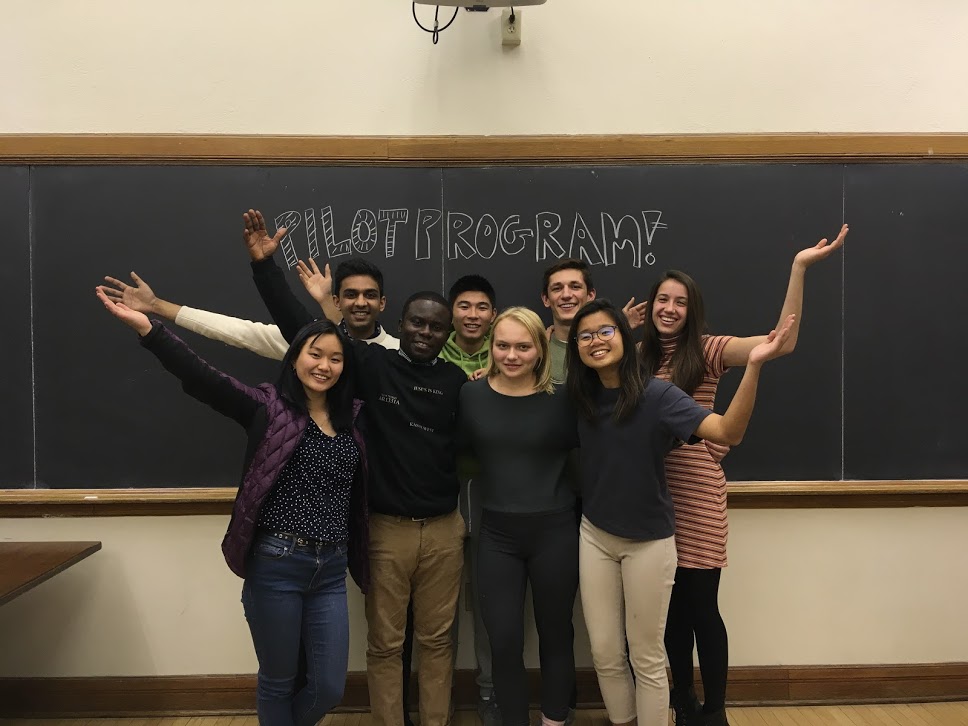Youth Continuum takes an innovative approach
to tackling homelessness
By Jane Latus
On Grand Avenue in downtown New Haven – a short walk from Yale University and sharing the block with an Italian bakery, flooring store and dry cleaner – is a nondescript building where young lives are being changed.
And when renovations are complete in 2021, the larger, more distinctive building will have a correspondingly new and unique program going on within: the first in the state (and second in the nation) student-run program for homeless young adults.
The Grand Avenue building is already home to New Haven’s only drop-in center for young homeless adults (ages 16-24). Every year, nearly 200 new youth and young adults enter the center run by Youth Continuum, the most comprehensive service provider to homeless youth in the state.
There, homeless young people have – most important of all – a warm, safe place to spend the day. And while inside, they have access to basic needs like food, showers, laundry, computers, hygiene supplies, clothes and diapers. Case managers and mental health providers are always available, no appointment necessary. Youth learn life skills like how to budget and interview for a job. They get help finding jobs and permanent housing.
But the center is only open 9-5 weekdays, so at 5 p.m., out they go. And although Youth Continuum has 12 beds, they are in another location. And they are the only beds in the city reserved for young adults. And they are never enough.
This will change thanks to Youth Continuum’s new program Y2Y New Haven, which stands for Youth-to-Youth, and renovations that will provide room for 24-hour services and crisis housing for 20 young adults.
“The goal is to have the capacity so homeless youth don’t have to be on a waiting list to get out of harm’s way,” Youth Continuum CEO Paul Kosowsky told Connecticut VOICE in January, at which time there were eight people waiting.
Construction is expected to begin this summer and finish within 12 months. The estimated $4 million project is being funded primarily by $3.25 million in state bonding, with Youth Continuum raising the rest.
New Haven’s homeless youth are no different from elsewhere, say Youth Continuum’s staff. They have been neglected, abused, trafficked for sex, or experienced horrors at the hands of adults. Odds are high (see sidebar, “Connecticut’s Homeless Challenge”) that they are LGBTQ.
New Haven’s LGBTQ youth also become homeless for the same reason as elsewhere, says Youth Continuum Director of Community Programs Kathy Grega. “I can’t think of one that hasn’t been [the result of] family rejection,” she says.
Complicating matters is that LGBTQ youth “are much more hesitant to access services. Their experiences are horrible, and they’ve earned the right to be cautious,” says Grega.
If it weren’t for Youth Continuum, most young adults wouldn’t seek shelter at all, Kosowsky says. “There are adult housing (centers) but they don’t want to go to them. A lot of kids had bad experiences with adults, so it takes a long time to gain their trust.”
Kosowsky shrugs his shoulders and turns up his palms. “They’re just normal kids. It doesn’t take much for young people to get thrown over the edge and become homeless.”
What makes Y2Y different
The secret is in the title: youth-to-youth. Youth Continuum trains volunteer college students to collaborate with staff to provide programming specific to, and driven by input from, the youths they serve.
Y2Y New Haven is modeled on Y2Y Harvard Square, which opened in Cambridge, Mass. in 2015 and is the first student-run shelter for young adults in the nation.
Y2Y Harvard Square co-founder Sam Greenberg says, “About a third of our young people have identified as LGBTQ+. In all likelihood, more are LGBTQ+ but don’t self-identify. We’ve worked really hard to make our space gender neutral. We’ve worked really hard to train our staff.”
He says clients “report that Y2Y feels different because of the trusting and safe relationships they build with each other and with staff.”
A noteworthy 81% of Y2Y Harvard Square’s departing clients “tell us they’re leaving Y2Y on what they feel confident is a pathway out of homelessness,” says Greenberg.
Youth Continuum is aiming for that same success in New Haven.
Y2Y New Haven’s mission is “to disrupt the cycle of homelessness for young people” via three steps: “sanctuary, pathways and advocacy.”
“If you can’t get them into housing, you can’t help them,” says Kosowsky of providing sanctuary.
“Pathways” refers to services provided to lead clients to stable housing.
Finally, Y2Y hopes former clients will become leaders in ending youth homelessness.
Who’s volunteering, and who’s helping whom?
Youth Continuum started training Y2Y volunteers in 2017, so students have already been at work in the Grand Avenue day center.
When the program is in full swing, Kosowsky expects to have 50 volunteers from New Haven’s several colleges.
Already, Youth Continuum’s staff sees the benefits of pairing youths with youths.
For one thing, young clients are more at ease with people their age. “Kids get a lot more out of a basic conversation over a deck of cards,” says Director of Housing Programs Tim Maguire.
Students are also a powerful complement to staff. “They bring enthusiasm, creativity, resources, motivation – clients see them in a different way than they do the professional staff,” says Kosowsky.
The program is also a two-way street. “Our kids see it as an opportunity to teach Yale kids what it’s like to grow up without any parents, or not the best parents,” says Grega. “There are a lot of honest conversations on the realities of city kids’ daily lives.”
“A kid at Yale and a kid with no home realize how easily they could be in each other’s positions. It’s a very powerful realization,” adds Kosowsky.
Lessons in bravery
Esther Ritchin is a member of the Y2Y New Haven Steering Committee and a 2020 Yale graduate. “I’m queer and have a lot of friends who are queer. I saw first-hand and learned about the real epidemic of homelessness in queer communities. I have friends who were kicked out of their homes and struggled with housing and having a safe place to stay. I was all too cognizant of how lucky I was to be loved by my family,” she says.
She started volunteering with Y2Y in 2018. “It’s really wonderful to be able to bond with someone in your age group who might be able to understand some of the things you’re dealing with, even though you don’t have the same problems,” she says.
Ritchin wishes everyone would understand that people aren’t to blame for their homelessness. “There is no fundamental difference between people who have housing or don’t have it. It’s circumstance.”
She tells of one client whose family kicked her out because of her sexuality. “She was smarter, more confident and more competent than I am, and we became friends.”
Ritchin says it’s possible that volunteers benefit more from clients than vice versa. “I’ve learned so much about strength and perseverance and bravery.”
Ultimately, she says, one of the most worthwhile things about volunteering is when clients find housing. “It’s always really wonderful to hear about it,” she says – including the details, like one man’s excitement over his dishwasher and under-cabinet lighting.
Life lessons, and life necessities
Of those who walk through the Grand Avenue center’s doors each year, “90 percent are constantly looking for shelter or stable housing,” says Grega.
One of the luckier kids, says Maguire, was a 21-year-old with a good income but living in his car. “He had a great job but needed to save money for a few months” to afford a security deposit.
Another young man moved to New Haven from Puerto Rico and needed help getting a birth certificate and other documents. “He’s employed off and on. We are still housing him,” says Maguire.
Even after finding good jobs, many can’t find housing without help, says Grega. “Landlords otherwise wouldn’t return a call from an 18-year-old. They can’t get a lease without being hooked up with a program like ours.”
“Many have dropped out of school, or a combination of lack of education and job experience makes long-term success not great,” says Kosowsky. “We teach budgeting, cooking, how to be a good neighbor, how to interview. They may have never seen a parent pay a bill. They have no concept what it means.”
Intervene now, and you can prevent generations of shelter families, he says.
Part of the neighborhood
“Initially, we had a fairly small but significant group of people who were opposed,” says Kosowsky of the zoning approval process. “Some people were thinking this would be an adult shelter, and there’d be lines out the door.”
But, he adds, “These kids are with us every day already. This is a continuation of what we’re already doing.” The only change will be that as many as 20 youths will be off the street overnight.
Youth Continuum spent a year meeting with local property owners, city officials and residents to garner support for the project, resulting in 120 letters and 180 petition signatures of support to the City Plan Commission. “That level of support really overwhelmed all of us,” says Kosowsky.
Youth Continuum has more plans for Y2Y, including collaborating with specialty fields of study at local colleges such as law schools, and engaging with the neighborhood by opening a youth-run storefront.








More Stories
Connecticut Sun: Playing for Good
Call Him Mister Connecticut: Jean Carlo Salazar’s Journey as Nurse, Model and Pageant Contestant
Ensuring a Seat at the Table